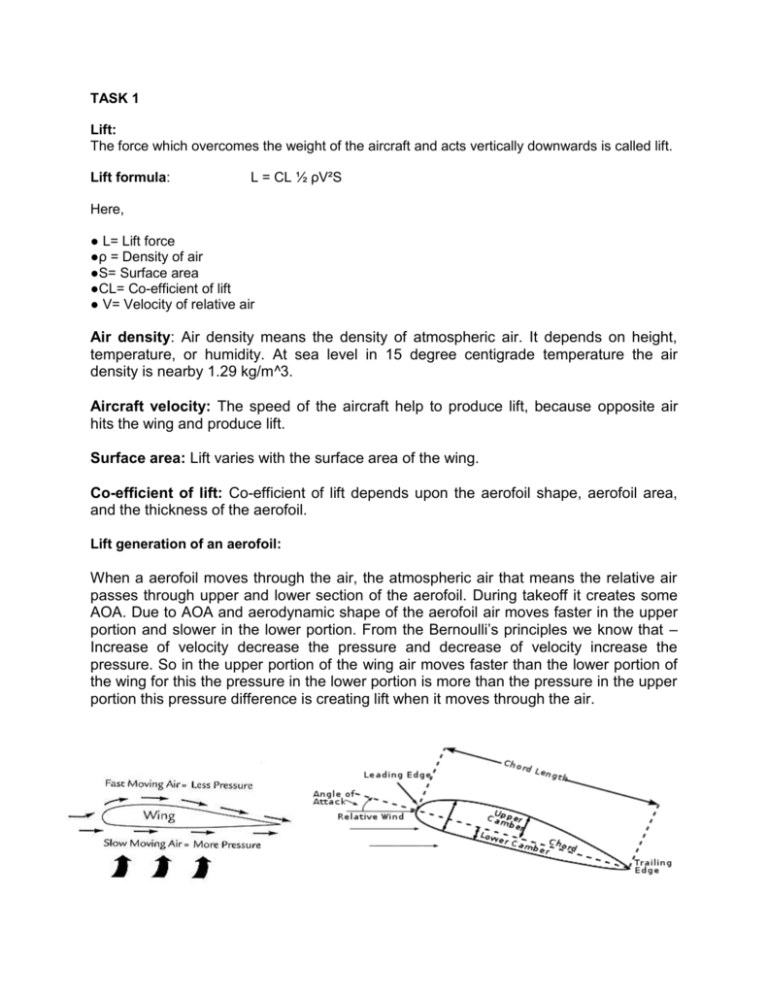File
advertisement

TASK 1 Lift: The force which overcomes the weight of the aircraft and acts vertically downwards is called lift. Lift formula: L = CL ½ ρV²S Here, ● L= Lift force ●ρ = Density of air ●S= Surface area ●CL= Co-efficient of lift ● V= Velocity of relative air Air density: Air density means the density of atmospheric air. It depends on height, temperature, or humidity. At sea level in 15 degree centigrade temperature the air density is nearby 1.29 kg/m^3. Aircraft velocity: The speed of the aircraft help to produce lift, because opposite air hits the wing and produce lift. Surface area: Lift varies with the surface area of the wing. Co-efficient of lift: Co-efficient of lift depends upon the aerofoil shape, aerofoil area, and the thickness of the aerofoil. Lift generation of an aerofoil: When a aerofoil moves through the air, the atmospheric air that means the relative air passes through upper and lower section of the aerofoil. During takeoff it creates some AOA. Due to AOA and aerodynamic shape of the aerofoil air moves faster in the upper portion and slower in the lower portion. From the Bernoulli’s principles we know that – Increase of velocity decrease the pressure and decrease of velocity increase the pressure. So in the upper portion of the wing air moves faster than the lower portion of the wing for this the pressure in the lower portion is more than the pressure in the upper portion this pressure difference is creating lift when it moves through the air. The effect of humidity, air temperature, and pressure on lift and drug forces: Pressure: It plays a great role for lifting of an aircraft. Increase or decrease of pressure effects on lift. We know that pressure is directly proportional to the density ( .P .. From the equation of lift (L), we see that lift is directly proportional to the density. L . So we can tell that if pressure increases then lift will increase and vice versa. So the standard pressure assumed by ISO is 1013.25mb or 101,325N/m^2 Humidity: Humidity is the density of vapor in the air. Humidity is inversely proportional to the density. humidity is also inversely proportional to the lift. So if humidity increases then lift will decrease and vice versa. Air temperature: Temperature has a great effect on lift and drag. When temperature increases it decreases the density and pressure. So at the time of takeoff more taxing speed and AOA is required. Task: 2 The basic forces which act during straight and level flight: At the time of flying an aircraft contains four basic forces they are; Lift: The force which overcomes the weight of the aircraft and acts vertically downwards is called lift. Due to pressure difference on upper and lower portion of the wing the lift force is created. Weight: The mass of all parts of the aircraft, amount of fuel, any payload on bord all this things creat weight. It acts through the center of gravity. This is the opposite of lift. Thrust: Thrust is a propulsive or reaction force which moves the aircraft forward. Engin passes the air from exast nozzol and this creats thrust, Due to Newton’s third law of motion thrust moves the aircraft forward. Drag: This is the air resistance. This is the resistance of atmosfheric air which oppos the aircraft to moves forward. The conditions of stright and level flight: At the time of stright and level flight the aircrraft four bassic forcess are equal in opposite direction. Lift = Weight Drag = Thrust The equation of stright and level flight to determine lift and drag force: Lift formula: L = CL ½ ρV²S Drag: D = Cd ½ ρV²S Here, ● L= Lift force ●ρ = Density of air ●S= Surface area ●CL= Co-efficient of lift ● Cd= Co-efficient of drag ● V= Velocity of relative air TASK: 3(a) Diving: If an aircraft moves forward with less thrust than drag then it maintains constant speed by diving. Sin = (D-T)/W Cos = L/W Figure: Force on aircraft in Diving Climbing: In constant speed where thrust is gratter than drag then it maintains constant speed by Climbing. Sin = (T-D)/W Cos = L/W Figure: Force on aircraft in Climbing. TASK-3(b) Here given that , Surface area of wing S = 200 square feet. = 200×0.09295 = 18.59 m2. Velocity v = 200mph. 200 ×1609.344 = = 89.408ms-2. 3600 Coefficient of lift CL = 0.7 Coefficient of drag CD = 0.5 Height = 10,000 feet At 10,000 feet the relative air density = 0.7385 So at 10,000 feet the air density (𝜌) = 0.7385 ×1.225 = 0.9046625 kg/m3 Lift: L = 1⁄2 CL 𝜌 v2 S = 1⁄2 × 0.7 × 0.9046625 × ( 89.408)2× 18.59 =47052.94196 N =47.05294196 KN.(Ans) Drag: D = CD 1⁄2 𝜌 v2S = 1⁄2 ×0.5× 0.9046625 × (89.408)2× 18.59 = 33609.24426 N = 33.60924426 KN.(Ans)







